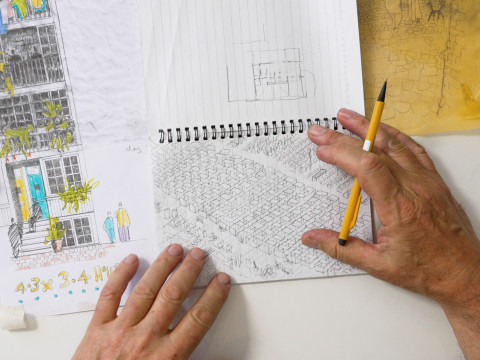
"It's about acceptance" – the drive to make architecture more inclusive
By Lois Innes
Published on 2 December 2019
The founder and director of Built By Us, a social enterprise that champions inclusion in architecture and the construction sector, is convinced that diversity is about far more than recruitment. Lois Innes reports.
From the Winter 2019 issue of RA Magazine, issued quarterly to Friends of the RA. Danna Walker spoke as part of the RA’s symposium Breaking Boundaries in June. Lois Innes is an architect and journalist; she has contributed to the Architect’s Journal and is a member of the Architecture Foundation’s New Architecture Writers programme
“Are we not due to meet at 11.30?” Danna Walker asks me, arching a perplexed eyebrow above her trademark, black-rimmed cat eye glasses.
I load up the Google calendar invite on my phone to confirm that we were due for an 11am start. She apologises, but there is no need: she has squeezed me into what is a full day’s schedule of consultations and meetings at her Brixton-based workspace. Walker is Director of the social enterprise Built By Us. Its objective? That by 2030, the company will have been influential in changing the face of the architecture and construction sector, so that it “reflects the society it serves and draws on the talents of a diverse workforce.” Clearly, she is on a mission.
In a place like London – a vibrant microcosm of the UK’s multi-cultural society – diversity enhances pretty much everything it touches: culture, conversation and the city as a whole. And as ever-increasing demands are placed on our built environment – from the quality of homes and public spaces to the promotion of ecologically sustainable materials and processes – the need to attract talent from a broader range of backgrounds is greater than ever. However, women and people from black and ethnic minority (BAME) backgrounds, as well as those from LGBT+ and disabled communities, remain underrepresented in the world of architecture; and attempts to model, understand and champion diversity are unacceptably slow. Heads of firms are still engaged in a cautious game of Jenga, working out where best to place their diversity initiatives within their corporate pyramid, so that it doesn’t somehow cave in on itself.
For Walker, it’s very simple: “It’s about acceptance.” Succinct and resolute, she is an individual who emanates a conviction that only great advocates have. Her curiously varied career spans 25 years. Once a shop floor electrician, she progressed into construction by becoming an architect and strategic project lead for the Construction Industry Council. She is also the former chair of RIBA’s equality, diversity and inclusion advisory group – Architects for Change – as well as being a former trustee of the Stephen Lawrence Charitable Trust. More recently, she became Board Director for Public Practice, a social enterprise that aims to reinvigorate the powers of the public sector by brokering placements for experts in the built environment within local authorities.

Since 2016, Built By Us has championed what Walker calls “untapped talent” through a programme of workshops and mentoring schemes. She was inspired to set up the company after witnessing years of inertia, and also from a personal history of exclusion. When she proposed a vocation in the arts, at the age of 16, a careers advisor suggested she consider working in a bank, or for slightly more pay, become a despatch driver. “I can remember thinking, ‘I have no clue, no idea of who I am,’” she says. “The things I thought I could do, I was being told I couldn’t.”
Those lines haven’t budged much since – in fact, they may have hardened. Gender (in the binary form we traditionally understand it) and equal pay have long been the focus of campaigns within architecture. The recently RIBA-launched #CloseTheGap pledge reflects changes to UK law, encouraging practices to consider the improvement of their gender pay gap performance as a “top priority”. But only 14 practices this year were legally required to report, based on a stipulation of having 250 employees or more – with the rest free to disclose data voluntarily. The move might also have been more convincing had RIBA’s own gender pay gap not increased by 5 per cent last year.
Race is not a new issue either, but it drew attention again in May, when Architects’ Journal published the results of its first race diversity survey – actually it was the first of its kind in architecture, anywhere. It was conducted in partnership with the Stephen Lawrence Charitable Trust close to the 25th anniversary of Lawrence’s racially-motivated murder. The survey reveals a catalogue of disquieting statistics. Of almost 900 surveyed, a third identified as BAME, 23.4 per cent of whom believed racism to be “widespread” in the architecture profession (compared to 9 per cent of white respondents); 24 per cent of BAME respondents claimed to have been victims of racism at their workplace, with one claiming to have witnessed colleagues dressing up in blackface for an event; and 7 out of 10 BAME surveyees believed their ethnicity created barriers to career progression.
“So,” she continues, “I thought that if I could get into a trade, becoming an electrician, that could support me financially, but also act as a springboard into something else.” Her two years as an apprentice were marked by a fresh set of prejudices and opportunities alike. “The guys certainly didn’t take me seriously,” she says, “but I enjoyed learning from them all the same.” When that springboard moment came in 1993 – via an access course to study architecture at university – there were similar barriers. “I was faced with all these new assumptions of how I should behave, and in both of those early experiences, there were particular lines around education and around expectations depending on class, gender and race.”
Throw the growing inequalities of financial class into the mix, and the profession is faced with a problem tantamount to crisis. “Now we have the high fees of higher education in place, there’s a language of not having, of poverty,” Walker explains. “We’re not talking about minorities in difficulty anymore, we’re talking about the majority.”
The problem with many workplace gender and diversity reports is in the choice of measurement: employee percentage ratios, which are a poor barometer. “You can choose to employ as many x, y, z people as you like, but if you don’t cultivate an environment that’s comfortable for them, they will simply leave,” Walker says. The missing ingredient, therefore, has to be inclusion. In the context of the workplace, inclusion isn’t just installing a gender-neutral toilet. It’s a top-down, transformative programme that involves, empowers and values all employees. How easily can that be implemented in architecture, a profession whose gatekeepers are still resoundingly white and male?
Built By Us believes that if we see diversity solely as an issue of recruitment, separate from workplace culture, we just speed up the revolving door of talent. “This is a foundational and structural issue,” Walker explains. “If firms want to retain and sustain talented architects, a much more holistic approach is going to be required.”
Built By Us strongly promotes its mentoring schemes to these ends. “The way we learn is often derived from individual relationships, or from little bits of advice we’re given in unlikely places,” Walker stresses. I can attest to that from my own experience of the exorbitant, multi-year long exercise of becoming an architect. Our education is obtained from universities, our industry experience from on-the-job learning, and our final accreditation from an ability to memorise the complete works of the Approved Documents. Seldom in this lengthy process do we learn architectural savvy, that is: to know the difference between worthwhile projects and more onerous ones; how to market and promote yourself effectively without a portfolio of completed projects; how to win those projects in the first place; or even who in the industry to call when you need a favour or two. This is where the benefits of increased personal exchange – with industry professionals, or simply those with valuable insights to share – could play its part.
You can choose to employ as many x, y, z people as you like, but if you don’t cultivate an environment that’s comfortable for them, they will simply leave.
Danna Walker
I ask Walker what the resistance to change reveals about who’s at the top, and what they believe they’ll stand to lose. “Whenever there’s a challenge to the status quo, people treat it as a perceived threat,” she replies. “Actually, I don’t see it as a zero sum game. Diversity is genuinely good for business models and that has been more than well documented.” In 2017, leading management consultancy firm McKinsey & Co examined over 1,000 companies in 12 countries. Their report found that firms in the top quartile for gender diversity are 21 per cent more likely to see above-average profitability than companies in the bottom quartile. Meanwhile, those in the top quartile for ethnic and racial diversity were 33 per cent more likely to have financial returns above their industry average.
Walker is adamant that architecture firms unwilling to infuse their operations with a broader set of individuals, who have a broader set of skills, will ultimately fail in the competitive market as we enter a new era of innovation. “The thinking of the past was to be protective, but it never truly is, is it?” Walker says. “Despite all the efforts to protect, we still end up with new disciplines and challenges.” True. An architect has more work to do than ever before: services have extended way beyond the traditional remit, to include anything from fashion design to the latest VR technology. What skills then, does an architect qualifying in 2050 need? Would they even be called an architect? Diversity offers a clear departure point from which to engage with these questions. “Someone who comes from a different background will always ask the best question, which is, ‘Why?’”
As our conversation widens, I divulge some of my own sentiments on diversity. As someone who outwardly represents the underrepresented face of the architectural profession – I am black and a woman – diversity can often feel like some sort of perceived raison d’être, a pedestal I must take to proclaim all of the profession’s ills, while simultaneously being subject to them. I ask Danna if she has ever felt the same way, and whether being a spearhead for change produces any problems for her self-esteem. “‘Yes’ is the short answer. But then I can remember not being in these positions and feeling underrepresented,” she recalls, half-smiling. “With the energy and drive for change finally here, we need to have patience with those who want to understand. From being 16 and starting that apprenticeship and having no-one to speak to, to now being that person who someone can approach – for me that’s a privilege and honour.”

Enjoyed this article?
As well as free entry to all of our exhibitions, Friends of the RA enjoy one of Britain’s most respected art magazines, delivered directly to your door. Why not join the club?
Related articles

Crunch: inside the first Architecture Window display
14 February 2024

RA Architecture Prize Winner 2023: Shane de Blacam
1 September 2023

Introducing Bêka & Lemoine
9 August 2023

In the studio: Peter Barber RA
27 July 2023

